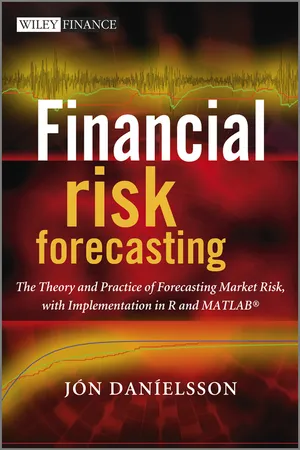
Financial Risk Forecasting
The Theory and Practice of Forecasting Market Risk with Implementation in R and Matlab
Jon Danielsson
- English
- ePUB (adapté aux mobiles)
- Disponible sur iOS et Android
Financial Risk Forecasting
The Theory and Practice of Forecasting Market Risk with Implementation in R and Matlab
Jon Danielsson
À propos de ce livre
Financial Risk Forecasting is a complete introduction to practical quantitative risk management, with a focus on market risk. Derived from the authors teaching notes and years spent training practitioners in risk management techniques, it brings together the three key disciplines of finance, statistics and modeling (programming), to provide a thorough grounding in risk management techniques.
Written by renowned risk expert Jon Danielsson, the book begins with an introduction to financial markets and market prices, volatility clusters, fat tails and nonlinear dependence. It then goes on to present volatility forecasting with both univatiate and multivatiate methods, discussing the various methods used by industry, with a special focus on the GARCH family of models. The evaluation of the quality of forecasts is discussed in detail. Next, the main concepts in risk and models to forecast risk are discussed, especially volatility, value-at-risk and expected shortfall. The focus is both on risk in basic assets such as stocks and foreign exchange, but also calculations of risk in bonds and options, with analytical methods such as delta-normal VaR and duration-normal VaR and Monte Carlo simulation. The book then moves on to the evaluation of risk models with methods like backtesting, followed by a discussion on stress testing. The book concludes by focussing on the forecasting of risk in very large and uncommon events with extreme value theory and considering the underlying assumptions behind almost every risk model in practical use – that risk is exogenous – and what happens when those assumptions are violated.
Every method presented brings together theoretical discussion and derivation of key equations and a discussion of issues in practical implementation. Each method is implemented in both MATLAB and R, two of the most commonly used mathematical programming languages for risk forecasting with which the reader can implement the models illustrated in the book.
The book includes four appendices. The first introduces basic concepts in statistics and financial time series referred to throughout the book. The second and third introduce R and MATLAB, providing a discussion of the basic implementation of the software packages. And the final looks at the concept of maximum likelihood, especially issues in implementation and testing.
The book is accompanied by a website - www.financialriskforecasting.com – which features downloadable code as used in the book.
Foire aux questions
Informations
Financial markets, prices and risk
| T | Sample size |
| t = 1, …, T | A particular observation period (e.g., a day) |
| Pt | Price at time t |
 | Simple return |
 | Continuously compounded return |
| yt | A sample realization of Yt |
| σ | Unconditional volatility |
| σt | Conditional volatility |
| K | Number of assets |
| ν | Degrees of freedom of the Student-t |
| t | Tail index |


